Novel roles for LIX1L in promoting cancer cell proliferation through ROS1-mediated LIX1L phosphorylation
- PMID: 26310847
- PMCID: PMC4550850
- DOI: 10.1038/srep13474
Novel roles for LIX1L in promoting cancer cell proliferation through ROS1-mediated LIX1L phosphorylation
Abstract
Herein, we report the characterization of Limb expression 1-like, (LIX1L), a putative RNA-binding protein (RBP) containing a double-stranded RNA binding motif, which is highly expressed in various cancer tissues. Analysis of MALDI-TOF/TOF mass spectrometry and RNA immunoprecipitation-sequencing of interacting proteins and the microRNAs (miRNAs) bound to LIX1L revealed that LIX1L interacts with proteins (RIOK1, nucleolin and PABPC4) and miRNAs (has-miRNA-520a-5p, -300, -216b, -326, -190a, -548b-3p, -7-5p and -1296) in HEK-293 cells. Moreover, the reduction of phosphorylated Tyr(136) (pTyr(136)) in LIX1L through the homeodomain peptide, PY136, inhibited LIX1L-induced cell proliferation in vitro, and PY136 inhibited MKN45 cell proliferation in vivo. We also determined the miRNA-targeted genes and showed that was apoptosis induced through the reduction of pTyr(136). Moreover, ROS1, HCK, ABL1, ABL2, JAK3, LCK and TYR03 were identified as candidate kinases responsible for the phosphorylation of Tyr(136) of LIX1L. These data provide novel insights into the biological significance of LIX1L, suggesting that this protein might be an RBP, with implications for therapeutic approaches for targeting LIX1L in LIX1L-expressing cancer cells.
Figures

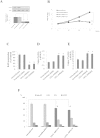
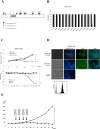
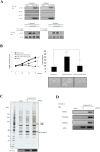
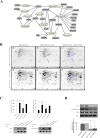
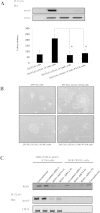
Similar articles
-
miR-27b-3p suppresses cell proliferation through targeting receptor tyrosine kinase like orphan receptor 1 in gastric cancer.J Exp Clin Cancer Res. 2015 Nov 14;34:139. doi: 10.1186/s13046-015-0253-3. J Exp Clin Cancer Res. 2015. PMID: 26576539 Free PMC article.
-
MicroRNA-1225-5p inhibits proliferation and metastasis of gastric carcinoma through repressing insulin receptor substrate-1 and activation of β-catenin signaling.Oncotarget. 2016 Jan 26;7(4):4647-63. doi: 10.18632/oncotarget.6615. Oncotarget. 2016. PMID: 26684358 Free PMC article.
-
Luteolin exerts a marked antitumor effect in cMet-overexpressing patient-derived tumor xenograft models of gastric cancer.J Transl Med. 2015 Feb 1;13:42. doi: 10.1186/s12967-015-0398-z. J Transl Med. 2015. PMID: 25638174 Free PMC article.
-
Silencing the double-stranded RNA binding protein DGCR8 inhibits ovarian cancer cell proliferation, migration, and invasion.Pharm Res. 2015 Mar;32(3):769-78. doi: 10.1007/s11095-013-1219-9. Pharm Res. 2015. PMID: 25823356 Free PMC article.
-
RNA binding motif protein 3: a potential biomarker in cancer and therapeutic target in neuroprotection.Oncotarget. 2017 Mar 28;8(13):22235-22250. doi: 10.18632/oncotarget.14755. Oncotarget. 2017. PMID: 28118608 Free PMC article. Review.
Cited by
-
G protein-coupled estrogen receptor 1 (GPER-1) and agonist G-1 inhibit growth of ovarian cancer cells by activation of anti-tumoral transcriptome responses: impact of GPER-1 mRNA on survival.J Cancer Res Clin Oncol. 2020 Dec;146(12):3175-3188. doi: 10.1007/s00432-020-03333-4. Epub 2020 Aug 19. J Cancer Res Clin Oncol. 2020. PMID: 32813115 Free PMC article.
-
A-to-I edited miR-154-p13-5p inhibited cell proliferation and migration and induced apoptosis by targeting LIX1L in the bladder cancer.J Cancer. 2024 May 13;15(12):3708-3723. doi: 10.7150/jca.93388. eCollection 2024. J Cancer. 2024. PMID: 38911375 Free PMC article.
-
LIX1-like protein drives hepatic stellate cell activation to promote liver fibrosis by regulation of chemokine mRNA stability.Signal Transduct Target Ther. 2021 Sep 1;6(1):319. doi: 10.1038/s41392-021-00665-6. Signal Transduct Target Ther. 2021. PMID: 34465730 Free PMC article. No abstract available.
-
DCHS1, Lix1L, and the Septin Cytoskeleton: Molecular and Developmental Etiology of Mitral Valve Prolapse.J Cardiovasc Dev Dis. 2022 Feb 17;9(2):62. doi: 10.3390/jcdd9020062. J Cardiovasc Dev Dis. 2022. PMID: 35200715 Free PMC article.
-
Limb expression 1-like protein promotes epithelial-mesenchymal transition and epidermal growth factor receptor-tyrosine kinase inhibitor resistance via nucleolin-mediated ribosomal RNA synthesis in non-small cell lung cancer.Cancer Sci. 2023 Apr;114(4):1740-1756. doi: 10.1111/cas.15687. Epub 2022 Dec 20. Cancer Sci. 2023. PMID: 36478492 Free PMC article.
References
-
- Swindell E. C., Moeller C., Thaller C. & Eichele G. Cloning and expression analysis of chicken Lix1, a founding member of a novel gene family. Mech Dev. 109, 405–408 (2001). - PubMed
-
- Moeller C., Yaylaoglu M. B., Alvarez-Bolado G., Thaller C. & Eichele G. Murine Lix1, a novel marker for substantia nigra, cortical layer 5, and hindbrain structures. Brain Res Gene Expr Patterns. 1, 199–203 (2002). - PubMed
Publication types
MeSH terms
Substances
LinkOut - more resources
Full Text Sources
Other Literature Sources
Medical
Molecular Biology Databases
Research Materials
Miscellaneous

